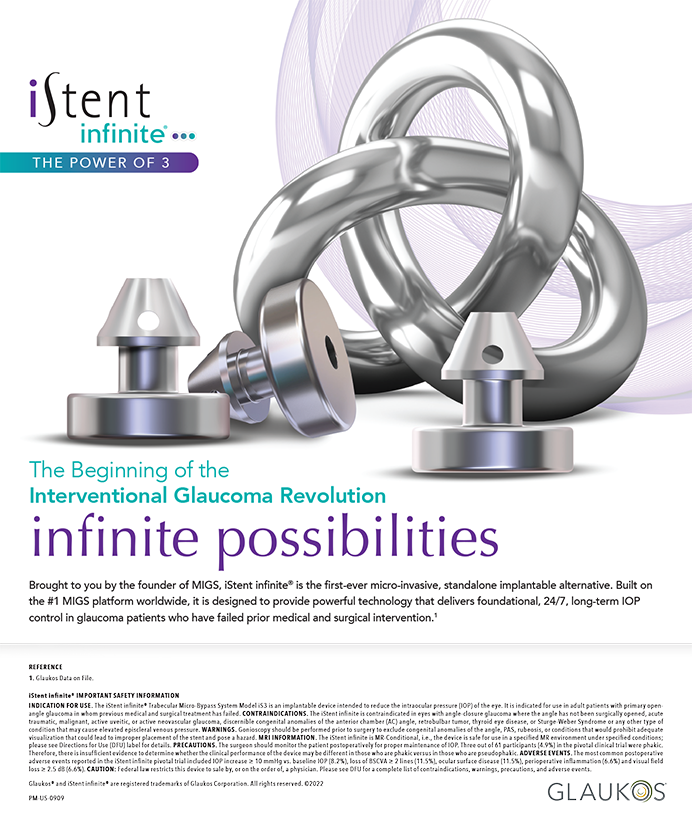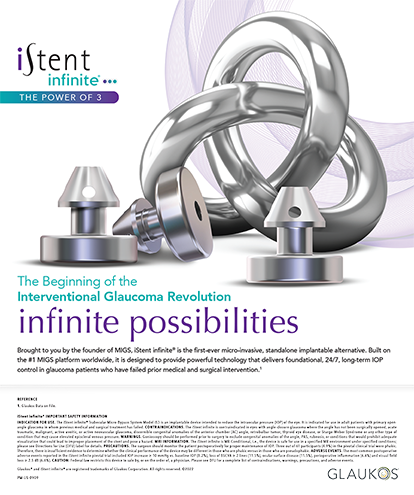PROSPECTIVE EVALUATION OF MICROINVASIVE GLAUCOMA SURGERY WITH TRABECULAR MICROBYPASS STENTS AND PROSTAGLANDIN IN OPEN-ANGLE GLAUCOMA
Ahmed I, Katz L, Chang D, et al1
ABSTRACT SUMMARY
Ahmed et al examined the change in IOP following the implantation of two trabecular microbypass stents (iStent Trabecular Micro-Bypass Stent; Glaukos) in conjunction with postoperative travoprost 0.004% (Travatan; Alcon) administration in 39 phakic patients with open-angle glaucoma (OAG).1 Patients enrolled in this prospective study had a preoperative IOP ranging from 18 to 30 mm Hg on two topical medications and had either visual field defects or an optic nerve appearance deemed consistent with glaucoma. On average, the enrolled patients had fairly mild OAG with a mean deviation of -6.47. All subjects had two iStents placed (one left-flow and one right-flow) 2 clock hours apart by one of six surgeons at the S. V. Malayan Ophthalmology Centre in Armenia. Travoprost was started on postoperative day 1 and continued except for a planned medication washout at the 13-month follow-up visit. At the time of publication, the investigators had collected data through 18 months following surgery.
The study found that OAG patients with two iStents and on one postoperative prostaglandin had a significant and sustained drop in IOP. At 12 months, all patients had an IOP reduction of at least 20% and an IOP less than 18 mm Hg. Mean medicated IOP dropped from 22.2 mm Hg (on two eye drops preoperatively) to less than or equal to 14 mm Hg at every time point thereafter, with each patient on only one medication. The mean IOP was as low as 11.8 mm Hg at the 18-month follow-up. The examination of IOP following 1 month of medication washout revealed a mean drop in IOP from 25.3 mm Hg preoperatively to 17.1 mm Hg at 13 months postoperatively (a 32.4% decrease).
No intraoperative adverse events occurred. Postoperatively, one patient had transient hypotony at 1 week and four patients had notable cataract progression over the 18-month period. Given that the mean subjects' age was 63, it was unclear if cataract formation was related to surgery or natural progression. Finally, cup-to-disc ratio and visual field mean deviation values were stable over the duration of the study.
DISCUSSION
Over the past several years, microinvasive glaucoma surgery with the first-generation ab interno trabecular microbypass stent (iStent) has grown in popularity among cataract and glaucoma surgeons alike for the treatment of mild to moderate OAG. Multiple prospective, randomized trials have demonstrated sustained IOP and medication reduction in patients undergoing concurrent phacoemulsification and iStent placement.2-4 Moreover, there appears to be greater IOP reduction in patients receiving two stents versus one at the time of cataract surgery.5,6 There is a paucity of data, however, regarding iStent implantation as a stand-alone procedure.
The Ahmed et al study was the first to evaluate the effect of iStent placement alone without cataract surgery. The synergistic effect of increased conventional outflow (via the stents) and increased uveoscleral outflow (with one prostaglandin) led to an impressive reduction in IOP, but more compelling was the 32.4% drop in mean IOP following medication washout, because it revealed the effect of iStent implantation alone without medication as a confounding variable.
The drop in IOP presented in this analysis is superior to data on the placement of single stents combined with cataract surgery2-4 and comparable to prior studies involving the placement of multiple stents in conjunction with phacoemulsification.5 In addition, this study further documents the outstanding safety profile of the iStent. Such a positive benefit-to-risk profile supports the use of multiple iStents as a stand-alone treatment to be used as an alternative to medications or as a modality to decrease the medication burden on OAG patients.
PROSPECTIVE UNMASKED, RANDOMIZED EVALUATION OF THE iSTENT INJECT VERSUS TWO OCULAR HYPOTENSIVE AGENTS IN PATIENTS WITH PRIMARY OPEN-ANGLE GLAUCOMA
Fea A, Belda J, Rekas M, et al7
ABSTRACT SUMMARY
Fea et al compared IOP reduction between 94 OAG patients with implantation of two iStent inject trabecular microbypass devices (model GTS400; Glaukos; commonly referred to as the G2) and 98 OAG patients receiving medical therapy consisting of a fixed combination of a prostaglandin and a b-blocker (latanoprost-timolol [Xalacom; Pfizer]). The prospective, randomized trial (also known as the Second Line Study) enrolled OAG patients whose pressures were not controlled on one medication from eight clinical sites and across six different countries (Italy, Spain, Poland, Germany, United Kingdom, and Armenia). Prior to randomization, all subjects underwent medication washout and were required to have an IOP between 22 and 33 mm Hg. All stents were placed in the nasal quadrant and separated by 2 to 3 clock hours. IOP, BCVA, and cup-to-disc ratio measurements were recorded over 12 months for both groups.
The study showed that the implantation of two iStent inject devices was at least as effective as two medications for lowering IOP in phakic OAG patients at all time points. At 12 months postoperatively, the mean IOP dropped from 25.2 to 13 mm Hg in the stent group and from 24.8 to 13.2 mm Hg in the medication group. Nearly all patients in both groups had an IOP reduction of at least 20% compared to baseline (stent group, 94.7%; medication group, 91.8%). There was a statistically significant difference in the subset of patients with at least a 50% reduction in IOP (stent group, 53.2%; medication group, 35.7%, P = .02). There were no intraoperative adverse events. The proportion of eyes with a BCVA better than 20/40 fell by 5% and 3% in the stent and medication groups, respectively, which was anticipated in a study population developing cataracts. The cup-to-disc ratio did not change appreciably over the course of the study.
DISCUSSION
Fea et al analyzed the placement of two iStent inject devices (a second-generation ab interno trabecular microbypass stent) as an alternative to a second medication in patients with OAG poorly controlled on one medication. The iStent inject differs from the first-generation iStent in that it is symmetrically designed with four orifices in the head of the device that rests in Schlemm canal. Given its peg-like symmetric design, inserting the iStent inject into Schlemm canal requires no sideways sliding, as is necessary with the iStent. Also, with the latest G2-M-IS injector system (Glaukos), two stents can be implanted with the same inserter without going in and out of the eye. Currently, the GTS400 is in clinical trials in the United States.
This study is noteworthy in the trabecular microbypass literature because of its large patient numbers and the presentation of a direct juxtaposition between medical treatment and stand-alone stent placement. In all outcome measures, the stent group performed equal to or better than the medication group. As has been the trend with other stent studies, the safety profile of the iStent inject was outstanding with no intraoperative complications.
Collectively, the studies by Ahmed et al and Fea et al highlight the efficacy of trabecular microbypass stent technology as a stand-alone procedure for the treatment of OAG. Both studies demonstrate that the use of two stents placed in the nasal quadrant results in a greater than 10-mm Hg decrease in IOP and a reduction of one medication. The notion that the implantation of multiple stents (the iStent or iStent inject) has the potential to be an alternative to glaucoma medications may help address several drawbacks to long-term topical medical therapy including cost, compliance, and ocular surface toxicity. While compelling, these studies are limited by their open-label nonrandomized design and the inclusion of a minimum qualifying IOP requirement, which may have resulted in a regression to the mean in favor of IOP reduction. The duration of follow-up (18 and 12 months) was relatively short, but existing 5-year postoperative data for the iStent combined with cataract surgery have been promising;4 it seems reasonable to assume that stand-alone stent placement would follow suit. n
1. Ahmed I, Katz L, Chang D, et al. Prospective evaluation of microinvasive glaucoma surgery with trabecular microbypass stents and prostaglandin in open-angle glaucoma. J Cataract Refract Surg. 2014:40;1295-1300.
2. Samuelson TW, Katz LJ, Wells JM, et al. Randomized evaluation of the trabecular micro-bypass stent with phacoemulsification in patients with glaucoma and cataract. Ophthalmology. 2011;118:459-467.
3. Craven ER, Katz LJ, Wells JM, et al. Cataract surgery with trabecular micro-bypass stent implantation in patients with mild-to-moderate open-angle glaucoma and cataract: two-year follow-up. J Cataract Refract Surg. 2012;38:1339-1345.
4. Arriola-Villalobos P, Martinez-de-la-Casa JM, Diaz-Valle D, et al. Combined iStent trabecular micro-bypass stent implantation and phacoemulsification for coexistent open-angle glaucoma and cataract: a long-term study. Br J Ophthalmol. 2012; 96:645-649.
5. Belovay GW, Naqi A, Chan BJ, et al. Using multiple trabecular micro-bypass stents in cataract patient to treat open angle glaucoma. J Cataract Refract Surg. 2012;38: 1911-1917.
6. Bahler CK, Hann CR, Fjield T, et al. Second-generation trabecular meshwork bypass stent (iStent inject) increases outflow facility in cultured human anterior segments. Am J Ophthalmol. 2012;153(6):1206-1213.
7. Fea A, Belda J, Rekas M, et al. Prospective unmasked randomized evaluation of the iStent Inject versus two ocular hypotensive agents in patients with primary open-angle glaucoma. Clin Ophthalmol. 2014:8 875-882.
Section Editor Edward Manche, MD
• director of cornea and refractive surgery at the Stanford Eye Laser Center
• professor of ophthalmology at the Stanford University School of Medicine, Stanford, California
• edward.manche@stanford.edu
Zachary Zavodni, MD
• fellowship-trained glaucoma, cornea, and refractive surgeon at the Eye Institute of Utah, Salt Lake City
• adjunct clinical associate professor at the University of Utah John A. Moran Eye Center, Salt Lake City
• zzavodni@theeyeinstitute.com
• financial disclosure: none acknowledged
David Felsted
• medical student at Midwestern University Arizona College of Osteopathic Medicine, Glendale, Arizona
• dfelsted97@midwestern.edu
• financial disclosure: none acknowledged


